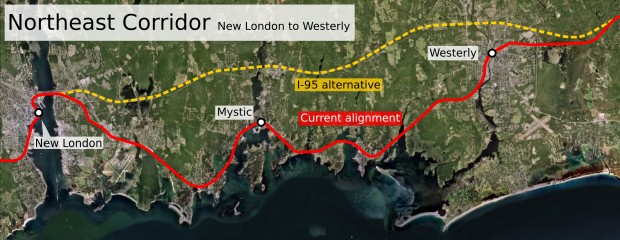The northeast corridor is the only true high speed rail line in the United States. Despite the unique distinction, the corridor is still considered painfully slow and unreliable, especially when compared to its perceived potential.
Focusing on the northern half of the route from New York and Boston, an Acela Express train currently takes 3h34 to travel the entire 229 miles for a pokey average service speed of 64 mph. Top speed of 150 mph is maintained for only 15 miles on two sections of track in Rhode Island and Massachusetts.
One of the major hurdles to improving trip times on the northeast corridor, as detailed in an Amtrak report and written about by The Transport Politic, is the maintenance backlog which has exceeded $8 billion. Given the huge sum required just to bring the corridor to a state of good repair, there is very little money left to make major trip time improvements.
Even then, it is frustrating to see how little gumption Amtrak has to propose truly transformative projects. Amtrak’s long-range goal for 2030 is to reduce trip times from New York to Boston by 34 minutes primarily by improving existing track conditions, capacity, and reliability throughout the corridor. While such improvements would be fantastic news, they would hardly be remarkable. Another report from Amtrak that may include proposals for further trip time reductions is due in October.
Significant improvements require significant investments
For an example of what could be a transformative improvement, lets focus on the segment between New London and Westerly. The corridor hugs the coastline most of its length with lots of curves and even a few grade grade crossings that limit service speed to around 60 mph. This segment will never be capable of supporting high speed operation as admitted by Amtrak:
Curvature along the coast between New Haven, CT and Westerly, RI will be difficult and very expensive to modify to accommodate higher speeds, particularly because of community and environmental mitigation requirements along a sensitive coast line.
The solution, obviously, is to move the rail corridor away from the coast. The likely alternative, as shown on the map below, is to closely follow the significantly straighter I-95 immediately to the north. And the trip time improvements such a realignment would produce are dramatic.

Amtrak currently takes 34 minutes to travel the 35 miles between New London and Kingston. If a new alignment were built along I-95 that supported 180 mph operation, a Siemens Velaro E train would be able to make the 31 mile journey in 16m17s. That is a trip time reduction of more than 17 minutes for just this small segment. And if a similar new alignment were a built between New Haven and New London, a further 25 minutes could potentially be shaved off the New York – Boston trip time.
Significant improvements often require significant investments. And if these projects were implemented, the Northeast Corridor could be recognized as a true high speed rail line instead of just being scoffed at.

Some relevant NEC speed related discussion here: http://rbiii.wordpress.com/2009/01/29/train-speeds-on-the-nec-part-iii/
I am not sure how easy it would be to build the corridor along the I-95 to 180 mph. Curvature currently allows for 150 mph operation without much eminent domain. I would however suggest because only one Acela stops at New London, bypass that until the Connecticut River and then connect to a 90 mph stretch (upgradable to 110 mph) section. That would save even more time. Here are the current 150 mph zonesMP 154.3 – 159.7 (5.4 mi)MP 160.5 – 170.5 (10.0 mi)MP 170.9 – 171.7 (0.8 mi)MP 174.5 – 180.1 (5.6 mi)MP 194.5 – 205.0 (10.5 mi)Total: 32.3 miBridging some of these gaps would most certainly help.